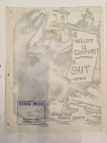
While most recollections of 1968 concern events in Paris, Germany, the US and South America, there was also a minor uprising in London. That is being commemorated with a suitably bijou single-room exhibition at the Tate Britain, and also a new publication in Four Corners’ Irregular series – about which I first wrote here.
The book is an anthology of the work of Camden’s Poster Workshop, a collective that silkscreen protest posters for any cause that needed them, directly inspired by the famous posters of Paris in May. It includes examples of every poster the group produced from their premises on Camden Road, plus essays explaining how they worked and their social context.
The graphics, slogans and general attitude are a perfect expression of the spirit of 1968, with campaigns focusing on big issues like Vietnam but also looking at very localised political issues such as rent strikes and student protests. There is a whole wall of those posters on display at the Tate, sitting opposite various artworks that capture the anti-establishment spirit of 1968 – a photograph by Richard Long, some work by Joseph Bueys.
In the space between are a handful of exhibition cases containing some ephemera related to 1968. Much of this relates to protests at Hornsey Art College and LSE, but there’s also some terrific King Mob and Anti-University paraphernalia, plus issues of IT and Black Dwarf. It’s definitely worth a quick look if you are planning to visit either of the current two main exhibitions, one on the impressionists on London and the excellent All Too Human, a very London-orientated featuring art by Freud, Bacon, Auerbach and Bomberg.
The King Mob elements particularly interested me, as this group had a striking way with word and image that anticipates – and inspired – the artwork of punk. “Comrades stop buggering about”, one pamphlet implores while another quotes Antonin Artaud in a perfect mix of the profane and the artful. They may well have been little more than annoying provocateurs, the Spiked Online of their day who said things like “football hooligans are the avant-garde of the British working class” but they certainly had wit. As Alan Marcuson explained to Jonathon Green in Days In The Life: “They were much more fun, their writings were more fun, they were a more interesting group of people, they were doing more interesting things, their pamphlets were more interesting than the boring fucking Trots, who really were the most tiresome bunch of people I have ever come across.”
King Mob were outliers in the London revolutionary scene. They formed in Notting Hill as an offshoot of the Situationist International. In ’68 – The Year Of The Barricades, David Caute writes that they “derided both passive, drugged hippies and the usual New Left rent-a-crowd who were forever ‘counting arseholes’ and pursuing stale ‘issue politics’.” It’s noticeable that there is no index entry for King Mob in Barry Miles’ history of the London counterculture, London Calling. That could be because one of King Mob’s first actions was to go to Miles’s Indica bookshop, where the hippie Trots of IT were then based, and “scaring the wits out of them”.
Like most left-wing revolutionary groups, King Mob believed they were the real thing. They articulated a keen sense of humour that was borrowed from the Yippies and Situationists, and also nurtured a belief in “creative violence” that they admired in New York’s brilliantly named and short-lived Motherfuckers. As a result, King Mob celebrated serial killers and planned audacious actions – blowing up a waterfall in the Lake District; hanging the peacocks in Holland Park – none of which came to pass.
Their most famous activity was when a group of King Mobbers, including Malcolm McLaren, invaded Selfridges dressed as Father Christmas and handed out toys to children. They are also said to have been responsible for some of London’s best graffiti, including the famous “How much more can you take?” in Ladbroke Grove. Their influence on the political climate of 1968 was minute, but McLaren and Jamie Reid would soon take King Mob’s love of ‘chaos and anarchy” and apply it to punk rock.
















